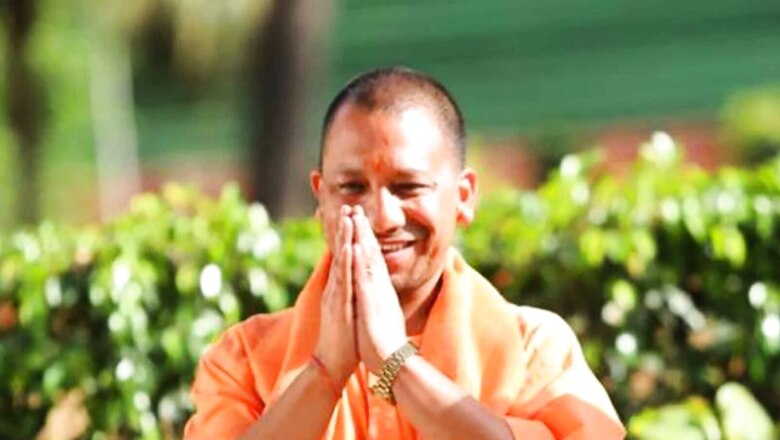
views
The loudspeaker row on Azaan and Hanuman Chalisa — topics of national altercations on national TV and political quarters — emerged from Maharashtra with Raj Thackeray of the Maharashtra Navnirman Sena (MNS) issuing an ultimatum regarding the purging of loudspeakers that hung over the minarets of mosques, moved to the Rana couple sailing on the same boat, and has now reached the most contentious and talked-about chief minister, Yogi Adityanath of Uttar Pradesh.
Following the orders issued by the UP administration, the police said that over 53,000 unauthorised loudspeakers have been uninstalled from diverse religious places, including temples, mosques, and gurudwaras, across the state, upholding the true spirit of secularism. “So far, till 7 a.m. (Sunday) in the morning today, 53,942 loudspeakers have been removed from various religious places across the state,” informed Prashant Kumar, Additional Director General of Police (Law and Order) in Uttar Pradesh.
Prior to this action, Uttar Pradesh chief minister Yogi Adityanath issued an advisory to restrict the volume of loudspeakers strictly inside the institution’s premises. Later on, the sound level of 60,295 loudspeakers was reduced and brought down to the level of standard parameters by the authorities. As fate would have it, the controversy that followed came on the heels of the communal violence witnessed around the recent Hindu festivities of Ram Navami and Hanuman Janmotsav in several states, and the issue has been heating up ever since. Yogi got a thumbs up from Raj Thackeray who said, “In Maharashtra, we don’t have ‘yogis’ in power; what we have are bhogis (hedonists).”
In fact, here’s what various courts, at various points in time, observed:
- Supreme Court (2005): In July 2005, the Supreme Court issued an order prohibiting the use of loudspeakers and music systems in public places between the hours of 10 p.m. and 6 a.m. (except in cases of public emergencies), citing the serious health effects of noise pollution on those who live in such areas.
- Bombay High Court (2016): In August 2016, the Bombay High Court declared that using loudspeakers was not a basic right. According to the Bombay High Court, no religion or sect could argue that the ability to use a loudspeaker or public address system constituted a basic right protected by Article 25 of the Indian Constitution.
- Uttarakhand High Court (2018): “Even after 12 a.m., the loudspeakers continue to blare.” According to the court, “the loudspeaker cannot be used without formal authorisation from the administration, even by temples, mosques, and gurdwaras.”
- Karnataka High Court (2021): The Karnataka High Court ordered the state government to take action against unauthorised loudspeakers at religious sites across the state in January 2021. It directed the state government to give urgent instructions to the police and the Karnataka State Pollution Control Board (KSPCB) to take action against the use of amplifiers and loudspeakers in religious buildings, citing noise pollution regulations and Supreme Court rulings as justification. The Karnataka High Court then requested that the state government explain the legislative provisions that allow loudspeakers and public address systems in mosques, as well as what efforts are being made to curb their usage by November 2021.
- Haryana and Punjab High Courts: In July 2019, the Punjab and Haryana High Court issued an order prohibiting the use of loudspeakers in public areas, including religious organisations. According to the court, public address systems should only be utilised with prior approval and the noise level should never exceed the permissible limit.
Thus, by removing loudspeakers not just from mosques, but also from temples and gurudwaras, the Uttar Pradesh administration has set the best example of communal harmony and secularism. While it has been discussed at length how India identifies or rather ratifies itself as a “secular country” but is impudently not so, Yogi Adityanath seems to be on a rampage to bust the popular myths regarding the Nehruvian brand of secularism followed by the Left for decades.
Left academics, ideologues, and activists have cunningly branded and reduced secularism to having vile and slanderous opinions about Hindus and their cultures, thus proving shallowness of their “secular credentials” and their “solidarity” with the minority communities in India. Beyond the deeper meaning of the word, Oxford Dictionary defines secularism as “the belief that religion should not influence or be involved in the organisation of society, education, government, etc.” And this is exactly what the Yogi government is achieving, by challenging the set brand of secularism that relentlessly rests on minority appeasement. In Yogi Adityanath’s Uttar Pradesh, neither Vikas Dubey nor Mukhtar Ansari is spared. If loudspeakers are not utilised during aarti at temples such as Kashi Vishwanath Dham, Kaal Bhairav, Sankatmochan Temple, Durga Temple and Tulsi Manas Temple in Varanasi, the government has also pared down the level of loudspeakers located at the Gyanvapi Mosque.
Also Read: Opinion | Freedom to Celebrate Hindu Festivals is Under Attack by Radical Islamists
Ever since the saffron-clad chief minister came to power, he has put forth his no-nonsense policy in clear terms regarding crimes in Uttar Pradesh and said in an interview, “Agar apraadh karenge toh thok diye jayenge.” The toughest actions against criminals have been taken under the chief minister’s pet project ‘Operation Clean’ and the Yogi government seems to have got a firm control over the law and order in the state as the crime rate stands well below the national average. It is only worthy to note that not a single case of communal clashes, rioting, or even violence was observed in Uttar Pradesh, once considered an epicentre of riots, on the occasion of Ram Navami, while stone-pelting, violence, arson by Islamists were witnessed across the length and breadth of India.
However, the Indian variant of the Stockholm Syndrome is yet again making “liberals” the worst bigots who are out to decimate all the values they purportedly claim to uphold for good. The central theme that is being orchestrated to peddle a false narrative around violence is this: The Hindus triggered the local Muslim communities by playing “provocative music” and “raising slogans” while passing through the “Muslim areas”, but liberals must be careful in propagating this argument because by propagating it, they’ve reached the edge of the cliff and must know that their days of relevance are severely numbered. If merely playing music in a religious procession is “provocation” for violent acts being justified, not only is this a call for Hindus to concede more, restricting their religiosity to private spaces while Muslims are a given free hand to even pray in public places such as roads, but it also incentivises radical Muslims to keep using anarchy as leverage. This minorityism, a neologism for a political structure or process in which a minority segment of a population has a certain degree of primacy in the entity’s decision-making, has been the sine qua non of the Indian polity since 1947.
You should not be surprised to know that music acting as a “provocation” for violence is not new. In a chapter on communal aggression, B.R. Ambedkar expressed, “Another illustration of this spirit of exploitation is furnished by the Muslim insistence upon cow-slaughter and the stoppage of music before mosques. Music may be played before a mosque in all Muslim countries without any objection. Even in Afghanistan, which is not a secularised country, no objection is taken to music before a mosque. But in India, the Musalmans must insist upon its stoppage for no other reason than that the Hindus claim a right to it.” B.R. Ambedkar, infamous for his criticism of Hinduism, was all the more-brazenly sharp and brutally honest in his censure of Islam. However, it is ironic how two different treatises by the same man, critiquing two different communities, are read so differently, but certainly display the most fascinating cocktail of discrimination and the ‘victim card’ we witness, where even the onus of violence and arson by Islamists on the auspicious day of Ram Navami is laid at the door of the Hindus.
Coming back, CM Yogi, the first UP chief minister to take the oath for a second term, in a rally said that nowhere was there any tu-tu main main (arguments), leave alone riots and ruckus. “This is proof of UP’s new progressive way of thinking. Here, there is no place for riots and chaos. UP has demonstrated this on the anniversary of Ram Navami,” he added. In fact, the well-maintained law and order situation in Uttar Pradesh was the monk CM’s ace in the pack of cards this election. UP is relentlessly wooing businesses, experiencing the lowest crime rates, and maintaining communal harmony as an ideal state must. From Mulayam Singh’s infamous “ladke hai galti ho jaati hai” misogynistic argument opposing capital punishment for rape to Yogi Adityanath’s “agar apraadh karenge toh thok diye jayenge”, Uttar Pradesh has evidently come a long way!
Yuvraj Pokharna is a Surat-based educator, columnist, and social activist. The views expressed in this article are those of the author and do not represent the stand of this publication.
Read all the Latest Opinions here















Comments
0 comment